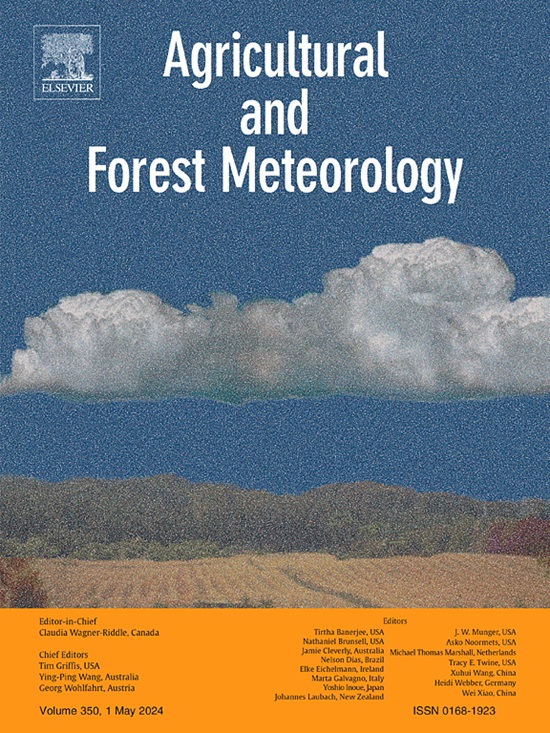The joint assimilation of satellite observed LAI and soil moisture for the global root zone soil moisture production and its impact on land surface and ecosystem variables
IF 5.6
1区 农林科学
Q1 AGRONOMY
引用次数: 0
Abstract
This study focused on the production of 18-year global root zone soil moisture (RZSM) by the joint land surface data assimilation using the satellite observed leaf area index (LAI) and surface soil moisture (SSM). The impact of the assimilation on RZSM, LAI, and other key surface variables was also assessed. The multilayer diffusion scheme, biomass and CO2 interactive scheme, and the simplified extended Kalman filter were applied in the model. It was found that the assimilation could effectively reduce the biases in LAI, and that the diverse regional effects on RZSM were varied with seasons, soil wetness, error covariance in the assimilation, and water transfer in the model. A downward increase of the RZSM pattern (< ∼ 0.03 m3 m-3) was found in vegetated regions with low to moderate soil wetness because of the reduced LAI by the assimilation. A general upward change of RZSM (within ∼ ±0.01 m3 m-3) was found in dry desert regions due to the assimilation of SSM. The evaluation for the central South America shows that the assimilation improved the correlation for SSM (0.9 to 0.91) and significantly reduced the mean biases of LAI (∼ 40%). Positive impacts on day/night land surface temperature (LST) were identified to be mostly through the RZSM and LST coupling, with the improvements in the range of ±1 or 2 K. The slight adverse impact of LAI over the Amazon forests had no degradations to RZSM and LST. The assessment of the impact on water, energy, and carbon cycles over France revealed that the strongest/weakest change was found in LAI (-6.3%)/deep layer soil water index (0.03%). Ecosystem respiration, sensible heat, and evapotranspiration had relatively large changes. The underlying mechanism of the impact supports the global analysis results, indicating that the joint assimilation is beneficial for drought monitoring and heatwave detection.
卫星观测到的 LAI 和土壤水分联合同化用于全球根区土壤水分生产及其对地表和生态系统变量的影响
本研究的重点是利用卫星观测到的叶面积指数(LAI)和表层土壤水分(SSM),通过联合地表数据同化生成 18 年全球根区土壤水分(RZSM)。还评估了同化对 RZSM、LAI 和其他关键地表变量的影响。模型采用了多层扩散方案、生物量和二氧化碳交互方案以及简化扩展卡尔曼滤波器。研究发现,同化可有效减少 LAI 的偏差,而 RZSM 所受的不同区域影响则随季节、土壤湿度、同化中的误差协方差以及模型中的水分传输而变化。在中低土壤湿度的植被区,由于同化降低了 LAI,RZSM 模式(< ∼ 0.03 m3 m-3)向下增加。在干燥的沙漠地区,由于 SSM 的同化,RZSM 普遍上升(±0.01 m3 m-3 以内)。对南美洲中部的评估表明,同化提高了 SSM 的相关性(从 0.9 提高到 0.91),并显著降低了 LAI 的平均偏差(± 40%)。对昼夜陆地表面温度(LST)的积极影响主要是通过 RZSM 和 LST 耦合确定的,改善幅度在 ±1 或 2 K 之间。评估对法国水循环、能量循环和碳循环的影响发现,变化最大/最弱的是 LAI(-6.3%)/深层土壤水分指数(0.03%)。生态系统呼吸作用、显热和蒸散作用的变化相对较大。影响的基本机制支持全球分析结果,表明联合同化有利于干旱监测和热浪探测。
本文章由计算机程序翻译,如有差异,请以英文原文为准。
求助全文
约1分钟内获得全文
求助全文
来源期刊
CiteScore
10.30
自引率
9.70%
发文量
415
审稿时长
69 days
期刊介绍:
Agricultural and Forest Meteorology is an international journal for the publication of original articles and reviews on the inter-relationship between meteorology, agriculture, forestry, and natural ecosystems. Emphasis is on basic and applied scientific research relevant to practical problems in the field of plant and soil sciences, ecology and biogeochemistry as affected by weather as well as climate variability and change. Theoretical models should be tested against experimental data. Articles must appeal to an international audience. Special issues devoted to single topics are also published.
Typical topics include canopy micrometeorology (e.g. canopy radiation transfer, turbulence near the ground, evapotranspiration, energy balance, fluxes of trace gases), micrometeorological instrumentation (e.g., sensors for trace gases, flux measurement instruments, radiation measurement techniques), aerobiology (e.g. the dispersion of pollen, spores, insects and pesticides), biometeorology (e.g. the effect of weather and climate on plant distribution, crop yield, water-use efficiency, and plant phenology), forest-fire/weather interactions, and feedbacks from vegetation to weather and the climate system.

 求助内容:
求助内容: 应助结果提醒方式:
应助结果提醒方式:


